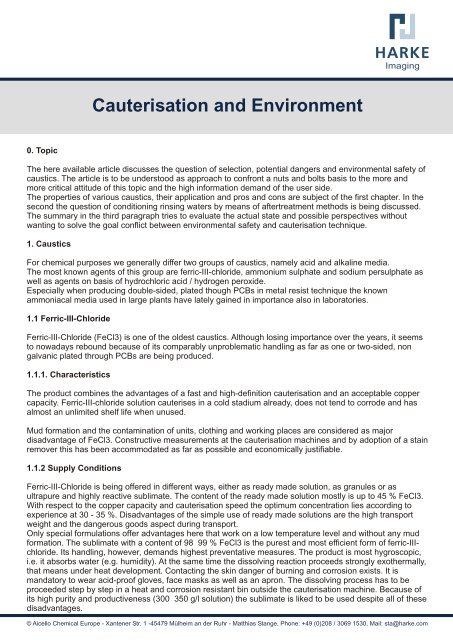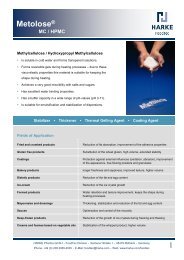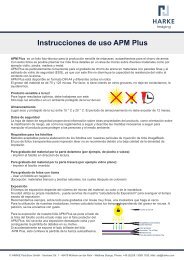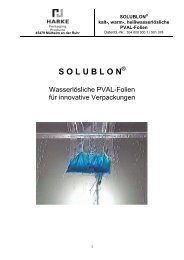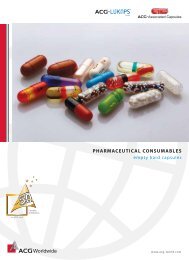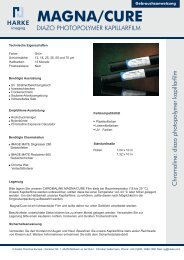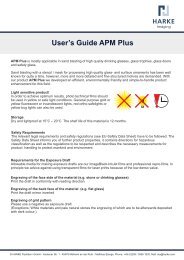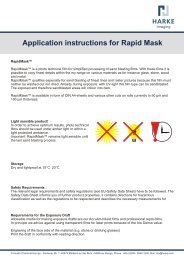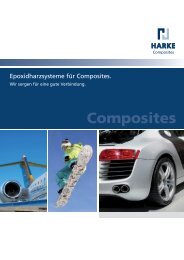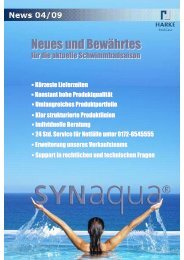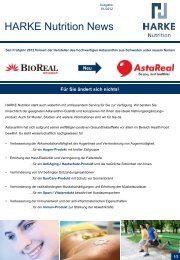Cauterisation and Environment - HARKE Group
Cauterisation and Environment - HARKE Group
Cauterisation and Environment - HARKE Group
Create successful ePaper yourself
Turn your PDF publications into a flip-book with our unique Google optimized e-Paper software.
0. Topic<br />
<strong>Cauterisation</strong> <strong>and</strong> <strong>Environment</strong><br />
Imaging<br />
The here available article discusses the question of selection, potential dangers <strong>and</strong> environmental safety of<br />
caustics. The article is to be understood as approach to confront a nuts <strong>and</strong> bolts basis to the more <strong>and</strong><br />
more critical attitude of this topic <strong>and</strong> the high information dem<strong>and</strong> of the user side.<br />
The properties of various caustics, their application <strong>and</strong> pros <strong>and</strong> cons are subject of the first chapter. In the<br />
second the question of conditioning rinsing waters by means of aftertreatment methods is being discussed.<br />
The summary in the third paragraph tries to evaluate the actual state <strong>and</strong> possible perspectives without<br />
wanting to solve the goal conflict between environmental safety <strong>and</strong> cauterisation technique.<br />
1. Caustics<br />
For chemical purposes we generally differ two groups of caustics, namely acid <strong>and</strong> alkaline media.<br />
The most known agents of this group are ferric-III-chloride, ammonium sulphate <strong>and</strong> sodium persulphate as<br />
well as agents on basis of hydrochloric acid / hydrogen peroxide.<br />
Especially when producing double-sided, plated though PCBs in metal resist technique the known<br />
ammoniacal media used in large plants have lately gained in importance also in laboratories.<br />
1.1 Ferric-III-Chloride<br />
Ferric-III-Chloride (FeCl3) is one of the oldest caustics. Although losing importance over the years, it seems<br />
to nowadays rebound because of its comparably unproblematic h<strong>and</strong>ling as far as one or two-sided, non<br />
galvanic plated through PCBs are being produced.<br />
1.1.1. Characteristics<br />
The product combines the advantages of a fast <strong>and</strong> high-definition cauterisation <strong>and</strong> an acceptable copper<br />
capacity. Ferric-III-chloride solution cauterises in a cold stadium already, does not tend to corrode <strong>and</strong> has<br />
almost an unlimited shelf life when unused.<br />
Mud formation <strong>and</strong> the contamination of units, clothing <strong>and</strong> working places are considered as major<br />
disadvantage of FeCl3. Constructive measurements at the cauterisation machines <strong>and</strong> by adoption of a stain<br />
remover this has been accommodated as far as possible <strong>and</strong> economically justifiable.<br />
1.1.2 Supply Conditions<br />
Ferric-III-Chloride is being offered in different ways, either as ready made solution, as granules or as<br />
ultrapure <strong>and</strong> highly reactive sublimate. The content of the ready made solution mostly is up to 45 % FeCl3.<br />
With respect to the copper capacity <strong>and</strong> cauterisation speed the optimum concentration lies according to<br />
experience at 30 - 35 %. Disadvantages of the simple use of ready made solutions are the high transport<br />
weight <strong>and</strong> the dangerous goods aspect during transport.<br />
Only special formulations offer advantages here that work on a low temperature level <strong>and</strong> without any mud<br />
formation. The sublimate with a content of 98 99 % FeCl3 is the purest <strong>and</strong> most efficient form of ferric-IIIchloride.<br />
Its h<strong>and</strong>ling, however, dem<strong>and</strong>s highest preventative measures. The product is most hygroscopic,<br />
i.e. it absorbs water (e.g. humidity). At the same time the dissolving reaction proceeds strongly exothermally,<br />
that means under heat development. Contacting the skin danger of burning <strong>and</strong> corrosion exists. It is<br />
m<strong>and</strong>atory to wear acid-proof gloves, face masks as well as an apron. The dissolving process has to be<br />
proceeded step by step in a heat <strong>and</strong> corrosion resistant bin outside the cauterisation machine. Because of<br />
its high purity <strong>and</strong> productiveness (300 350 g/l solution) the sublimate is liked to be used despite all of these<br />
disadvantages.<br />
© Aicello Chemical Europe - Xantener Str. 1 -45479 Mülheim an der Ruhr - Matthias Stange, Phone: +49 (0)208 / 3069 1530, Mail: sta@harke.com
Imaging<br />
The granules consist of about 60 % FeCl3 <strong>and</strong> 40 % chemically combined water <strong>and</strong> other substances. The<br />
less content of active substances require a larger quantity use than the sublimate, the granules, however, do<br />
not react exothermally when dissolving in water <strong>and</strong> therefore are much easier to h<strong>and</strong>le. From 800 g<br />
granules 56 % <strong>and</strong> 1 l water one gets about 1.4 litre 32 % solution.<br />
1.1.3 Application<br />
In an aqueous solution of ferric-III-chloride copper oxidizes to copper-II-chloride while the cauterisation<br />
agent passes into the less inferior ferric-II-chloride. At a make-up quantity of about 35 w/w % FeCl3 the<br />
maximum capacity of the cauterisation solution calculatively adds up to about 50 g copper / litre. The<br />
cauterisation duration in a fresh solution of about 45°C under optimum machine conditions lies in the range<br />
of about 2 seconds per 1 µm copper. It increases at first only slowly during the increasing consumption rate,<br />
but before reaching the saturation point rapidly. The calculatively possible copper absorption is in practice<br />
not being realised because of the decelerated cauterisation process <strong>and</strong> the increasing undercut of the<br />
pattern plate. Shortly before the saturation limit the cauterisation agent tends to intensify the formation of<br />
ferric- <strong>and</strong> copper chloride mud so that the cleaning process of the machine reasonably increases. The<br />
increase of the cauterisation duration to about the double start value therefore marks the economically most<br />
favourable moment to replace the cauterisation agent.<br />
1.1.4 <strong>Environment</strong>al Compatibility<br />
Used ferric-III-chloride solution cannot be recycled with justifiable costs. The possibility to dilute the solution<br />
by adding hydrochloric acid <strong>and</strong> at the same time to delay the starting mud formation is in practice not being<br />
used because this process will only be effective for a short time. An imaginable point for recycling according<br />
the latest legal situation would only be the acid concentration or the precipitation of the heavy metals from<br />
the solution <strong>and</strong> their afterwards smelting. According experience this recycling possibility, however, is only<br />
being met to a limited extent. Failing other alternatives the used solution has to be disposed as hazardous<br />
waste.<br />
In order to avoid a contamination of the workplace by cauterisation vapours, sufficient room ventilation is<br />
necessary when using ferric chloride. The aerosol formation especially appearing in spray cauterisation<br />
machines may lead to mucous membrane irritation. Additionally cauterisation vapours corrosively effect<br />
metal objects in the room strongly.<br />
1.1.5 Evaluation<br />
<strong>Cauterisation</strong> <strong>and</strong> <strong>Environment</strong><br />
The h<strong>and</strong>ling of ferric-III-chloride in form of granules is unproblematic. The use of the sublimate is subject to<br />
a strict due diligence when newly preparing the caustic solution. The sublimate is recommended because of<br />
its productiveness <strong>and</strong> unproblematic cauterisation behaviour for the use in often utilised or quasi continuous<br />
used laboratories. With reference to the hazardousness of the real ferric-III-chloride it has to be mentioned in<br />
the margin that it is being used in for instance waste water treatment plants as flocculants. Because of the<br />
possible copper content in the consumed solution it has, however, to be categorized as hazardous waste.<br />
© Aicello Chemical Europe - Xantener Str. 1 -45479 Mülheim an der Ruhr - Matthias Stange, Phone: +49 (0)208 / 3069 1530, Mail: sta@harke.com


